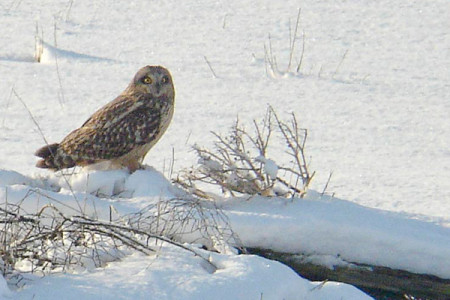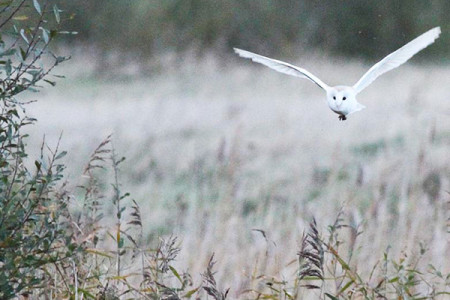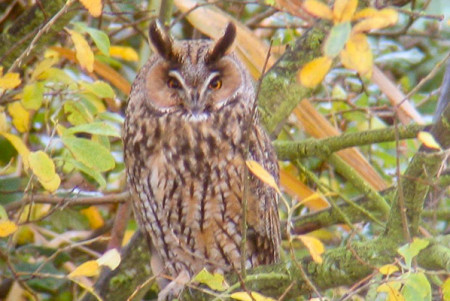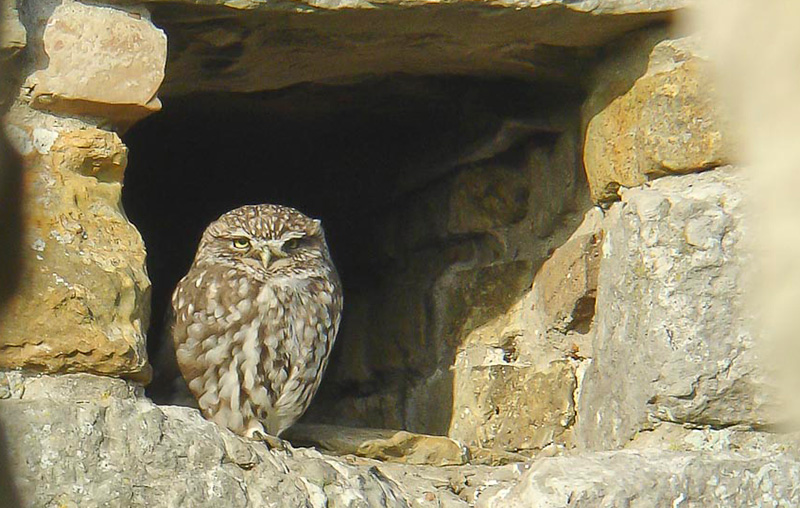Sometimes, when the High Street is very quiet in the depths of a cold winter’s night, you might be able to detect, on the periphery of your hearing, the distant calls of owls in the trees on the edge of the town. If you listen very carefully, you might be able to track the sound moving from one side of the town to the other. Residents of The Grove and Love Lane and the areas around the cemetery will be familiar with these calls, which often emanate from the woodland nearby, and in some cases loudly and persistently from right outside, in their own gardens.
So which types of these mysterious creatures are patrolling the edges of Rye? According to Dr Barry Yates, manager of Rye Harbour Nature Reserve, there are tawny, little and barn owls here all year round, which in winter are joined by long-eared and short-eared owls. (You can identify their different calls by listening to these sound files.) While you might assume owls are usually nocturnal animals, in fact little, barn and short-eared owls can be seen hunting in the daytime as well as during the night. Little owls in particular are a not uncommon sight during the daytime, and can become surprisingly tame around humans. One afternoon I saw one sitting on the post of the Rye sign at the top of the Udimore Road and, another time, one sitting on a fence near Iden, doing that very characteristic thing that owls do, rotating its head in a circle.
The little owl once had an important symbolic role in ancient Greece, where it was closely associated with the goddess Athene and the founding of the city of Athens. However, although it is relatively common across mainland Europe, it is not native to the UK and was introduced here comparatively recently, in the mid-19th century. Since then it has become well established, but at some cost to other wildlife.
Owls eat insects and small mammals, but they can also attack and eat other birds. At Rye Harbour, the little owl has been known to eat little terns and skylarks, which are two endangered species. In order to protect themselves, birds will sometimes mob an owl to frighten it off and alert other birds. One night recently I heard a little owl and a magpie suddenly start a very noisy fight directly above me in a tree at the front of the new community garden in Love Lane. The fight culminated with the owl suddenly shooting out of the tree at high speed. Because both birds had hitherto been silent, I had no idea that they were up there until they began to attack each other.

And this is the point about owls: they are creatures of stealth. If they are not calling – to mark out their territory or attract a mate – or getting into a fight with other birds, you as a human are very unlikely to know of their presence. All owls have very highly developed sensory acuity, particularly of vision and hearing. While you might not be aware of an owl, you can guarantee it will know all about you.
Owls have excellent night vision, with great perception of depth, but as their very large eyes are forward facing (unlike most birds of prey, whose eyes face sideways), they must turn their heads to be able to see all around. Special neck vertebrae and blood vessels mean they can rotate their heads through 270 degrees. However, they lack close vision and so when their food is nearby, they rely on a highly developed kinaesthetic sense to find it.
Some biologists believe that the barn owl has the most sensitive hearing of any animal in the world. As it flies low over the edges of woodlands and fields looking for mice and voles, a barn owl can detect and isolate very specific, tiny sounds from its overall sonic environment. Through sound alone it is able to work out precise locations and patterns of movement of potential prey, even prey hidden in long grass. Moreover, its super-sensitive hearing is untroubled by the turbulence of the passing air (see detailed explanation here). And like all owls it has special feathers that make its flight almost entirely silent: impossible for its prey to detect as it approaches.

Barn owls in particular require a large area in which to hunt, together with a particular type of grassy terrain found in open countryside and at the edges of woodland. We are fortunate that such large open spaces still exist in and around Rye, and so the population is able to thrive here, aided by the provision of many nesting boxes. However, nationally, numbers have greatly declined, the result of a combination of loss of habitat, use of pesticides and road accidents.
In the town you might sometimes hear a tawny owl calling in the distance. However, a few nights ago a male tawny appeared unexpectedly right in the centre, in the churchyard of St Mary’s. It was after midnight, in the rain, and the owl set about calling for a mate with its characteristic intermittent and very loud hooting sound for about 15 minutes. Sadly, despite the owl having chosen such a high vantage point – from where its sound could probably be heard for miles around – it seemed to go unanswered. It has yet to return.
And that reminds me of an old joke.
Every evening a man stood in his back garden in a village, making owl sounds. Eventually his efforts were rewarded and an owl called back to him. For many nights after that, the two called back and forth to each other. Then one day his wife happened to be speaking to a neighbour from the other side of the village. “My husband likes to call out to the owls at night,” she said. “That’s odd,” the neighbour replied. “So does mine.”
Additional information
See the Rye Harbour Nature Reserve website. General information about owls can be found here. A wealth of information about barn owls can be found here. And if you find an injured owl or other wild animal locally please contact RSPCA Mallydams.

Thank you to Dr Barry Yates, manager of Rye Harbour Nature Reserve, for his help in writing this article and providing photos of owls, all taken locally



